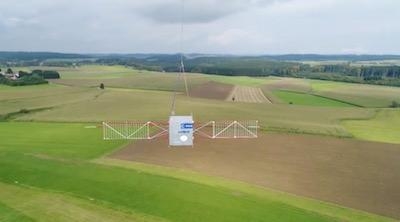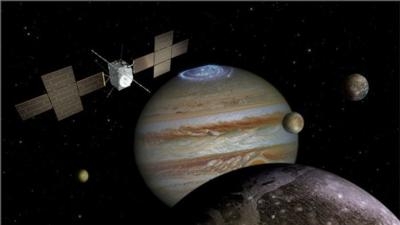JUICE Spacecraft Scheduled For Launch In 2022
A long radar boom that will probe below the surface of Jupiter’s icy moons has been tested on Earth with the help of a helicopter.

ESA’s Jupiter Icy Moons Explorer, Juice, is scheduled for launch in 2022, arriving seven years later. It will study Jupiter’s turbulent atmosphere and vast magnetic fields, as well as the planet-sized moons Ganymede, Europa and Callisto. All three moons are thought to have oceans of liquid water beneath their icy crusts and should provide key clues on the potential for such bodies to harbour habitable environments.
One way to determine the nature of the moons’ subsurface is to penetrate through the ice with radar. That will be the task of the Radar for Icy Moons Exploration instrument, which will be the first of its kind capable of performing direct subsurface measurements of worlds in the outer Solar System.
A 52-foot-long boom will be deployed after launch and, once at Jupiter’s moons, it will transmit radio waves towards the surface and analyse the timing and strength of their reflections from features buried down to about six miles. It will see vertical details as small as 165 feet. It will also help characterize the wide range of compositional, thermal and structural variations expected in the subsurfaces of these unique and geologically complex worlds.
In order to measure key characteristics of the antenna, and to verify computer simulations, a test was carried out using a helicopter operating out of a glider airport in Heiligenberg, close to Friedrichshafen, Germany, last week. The antenna was mounted on a simplified mock-up of the spacecraft and hung 500 feet below the helicopter, which hovered between 160 and 1,050 feet above the ground. The tests were performed with the antenna and solar array in horizontal and vertical orientations with respect to the spacecraft mock-up, to understand the interaction between the spacecraft components and the antenna, and to test the characteristics of the returned signals.

The helicopter offered the flexibility to fly close to the ground in agile maneuvers, including figure-of-eight trajectories. “All the experiments were completed and provided a large amount of data that will be analysed in the coming weeks for guiding the next steps of the instrument’s development and to improve the modelling of our software simulations developed in the laboratory,” says principal investigator Lorenzo Bruzzone from the University of Trento, Italy.
“The test was a fundamental step towards understanding the behaviour of the real antenna that will ultimately allow us to perform highly accurate measurements of the radar echoes reflected from the deep subsurface of the Jovian icy moons.”
Juice will fly by the moons at distances between 600 and 125 miles. It will also orbit Ganymede for nine months, with the latter four months at an altitude of about 300 miles.
While the oceans of Jupiter’s moons are likely buried at significant depth below their icy crusts, the radar will be able to help piece together clues as to their complex evolution. For example, it will explore Europa’s potentially active regions and be able to distinguish where the composition changes, such as if there are local, shallow reservoirs of water sandwiched between icy layers. It will be able to find ‘deflected’ subsurface layers, which will help to determine the tectonic history of Ganymede in particular. The distinction between ice and non-ice materials will also be possible, perhaps enabling the detection of buried cyrovolcanic reservoirs.
On Callisto, radar profiling will help to understand the evolution of large impact crater structures that are apparent on the surface, which typically display multiple rims and a central dome. Their nature provides clues to the nature of the surface and subsurface at the time of the impact. “Seeing into the subsurface of these moons with radar will be like looking back in time, helping us to determine the geological evolution of these enigmatic worlds,” says Olivier Witasse, ESA’s Juice project scientist.
“The radar is one of 10 instruments on our spacecraft that together will be the most powerful remote sensing, geophysical, and in situ payload complement ever flown to the outer Solar System.”
(Image provided with ESA news release)
 ANN's Daily Aero-Term (04.25.24): Airport Rotating Beacon
ANN's Daily Aero-Term (04.25.24): Airport Rotating Beacon ANN's Daily Aero-Linx (04.25.24)
ANN's Daily Aero-Linx (04.25.24) Klyde Morris (04.22.24)
Klyde Morris (04.22.24) Airborne 04.24.24: INTEGRAL E, Elixir USA, M700 RVSM
Airborne 04.24.24: INTEGRAL E, Elixir USA, M700 RVSM Airborne 04.22.24: Rotor X Worsens, Airport Fees 4 FNB?, USMC Drone Pilot
Airborne 04.22.24: Rotor X Worsens, Airport Fees 4 FNB?, USMC Drone Pilot




